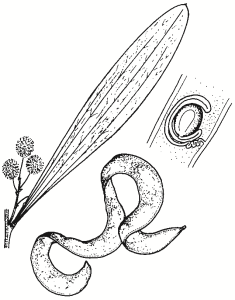Family:
Fabaceae
Acacia melanoxylon
Blackwood
Other Names: Mootchung, Burn-na-look

Name Origin:
From Greek melanos, black, and xylon, wood, referring to the dark timber.
Regional Subspecies:
Similar Species:
Distinguished from Hickory Wattle/Lightwood (A. implexa) by its ‘leaves’ which are not sickle- shaped, its flowering time and habitat (although they occasionally occur together). Also, the Blackwood funicle (ovule or seed stalk) is red and completely encircles the seed while the Lightwood funicle is cream and folded under the seed.
Occurrence:
Regional:
Widespread to the east of Hume Highway, in higher rainfall areas.
Australia:
Tas, Vic, NSW, Qld , SA. Distribution closely linked to rainfall.
Habitat:
Various habitats, chiefly wet sclerophyll forest and in or near cooler rainforest.
Habit:
Erect or spreading tree, 6-30 m high. Deeply fissured, dark grey to black bark. Dense foliage.
Site Preference:
Moist, well-drained fertile soil and cool climatic conditions. Tolerates a range of sites, including drier soil in exposed situations. Tolerates cold conditions and wind. Young plants may suffer frost damage.
Characteristics:
Long-lived. Young plants very shade-tolerant. Fire tolerant. Generally resistant to insect activity.
Flowering:
Pale yellow to whitish, usually Jul-Dec.
Seed Collection:
Around Dec-Mar. Frequently produces large crops. A large proportion of seed may be retained as late as Aug-Sep, although seed-eating insects may consume large amounts.
Propagation:
From scarified seed (± 58 viable seeds per gram). Pour boiling water over seed and soak for several hours before drying and sowing.
Regeneration:
From suckers or seed after disturbance such as fire, ripping or ploughing. Suckers freely from stumps and exposed roots. Palatable to livestock, hence fencing recommended to encourage regeneration. Establishes well when direct seeded.
VALUES:
Shade & Shelter:
Useful medium-level cover in windbreaks. In relatively open situations tends to grow quite bushy, retaining branches to ground level (useful in windbreaks). Useful paddock tree, as grass grows to trunk if light adequate, and resistant to livestock damage to the bark. Fencing recommended to preserve and regenerate trees.
Land Protection:
Useful in controlling erosion due to vigorous spreading roots and suckering. Legume — improves soil fertility through ‘fixing’ nitrogen.
Wildlife:
Provides pollen for native moths, butterflies and other insects, which attract insect-eating birds. Seeds eaten by insects and birds such as parrots and native pigeons. Furrows and cracks in bark provide habitat for various insects and spiders. Used for perching by hawking species, including birds of prey.
Fuel:
Moderate value.
Timber:
Highly regarded as cabinet and furniture timber. Used widely for veneers. One of the most decorative Australian timbers when polished. Timber golden-brown to dark-brown, sometimes with reddish tints or streaks with distinct growth rings, tough, hard and close-grained. Grain usually straight, but also wavy. Density about 650 kg/m3. Selected provenances have potential for commercial production of specialty high-value timber, on fertile high rainfall sites.
First Nations:
Spearthrowers and shields made from fine hard wood. Fishing lines made from inner bark fibre. An infusion of bark used to bathe rheumatic joints. Edible gum soaked in water to form jelly. Bark and twigs reputedly used to stupefy fish, enabling easy capture.
Ornamental:
Specimen or shade. Useful for screening. Dense crown and good form make it useful for parks and large gardens.
Other:
Edible gum. ‘Leaves’ produce lemon-fawn dye with the mordant alum.
